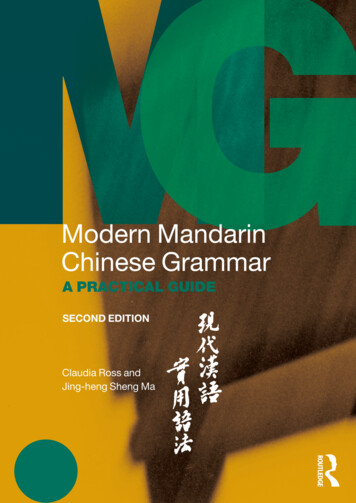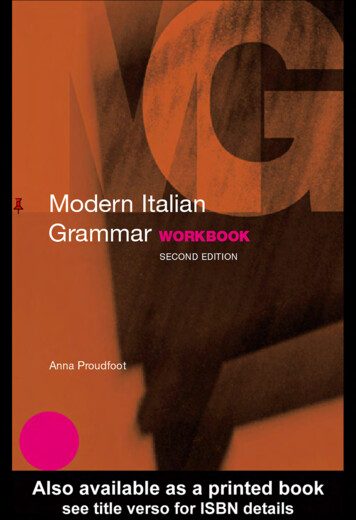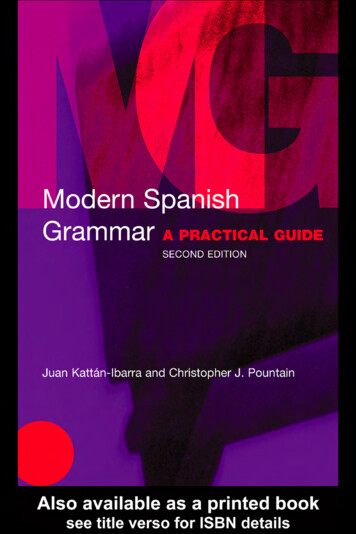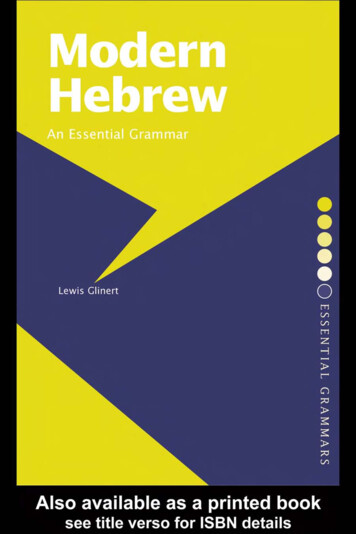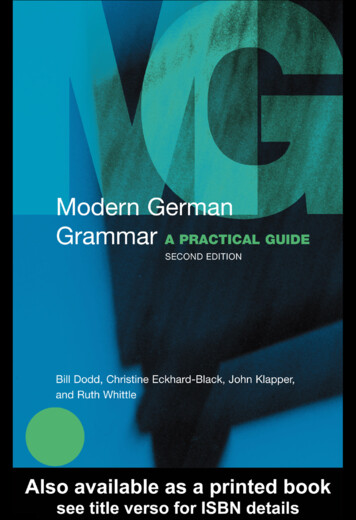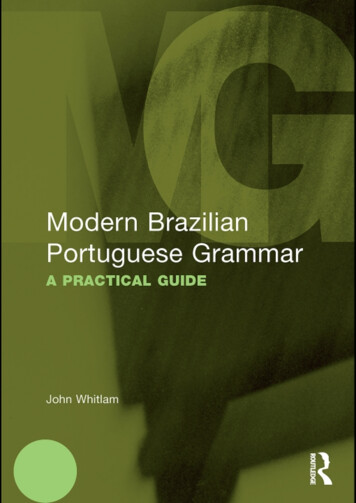
Transcription
ModernBRAZILIAN PORTUGUESEGrammarModern Brazilian Portuguese Grammar: A Practical Guide is an innovative referenceguide to Brazilian Portuguese, combining traditional and function-based grammar in asingle volume.The Grammar is divided into two parts. Part A covers traditional grammatical categoriessuch as agreement, nouns, verbs and adjectives. Part B is carefully organized aroundlanguage functions covering all major communication situations such as: Establishing identityMaking contactExpressing likes, dislikes and preferences.With a strong emphasis on contemporary usage, all grammar points and functions arerichly illustrated with examples. Main features of the Grammar include: Clear, jargon-free explanationsEmphasis on the language as it is spoken and written todayExtensive cross-referencing between the different sections.A combination of reference grammar and practical usage manual, Modern BrazilianPortuguese Grammar is the ideal source for learners of Brazilian Portuguese at all levels,from beginner to advanced.John Whitlam is a freelance writer, university lecturer and lexicographer based in Rio deJaneiro. He has authored a number of language teaching books and project-coordinatedand co-authored three of the best-selling bilingual dictionaries of Portuguese and English.
Routledge Modern GrammarsSeries concept and development – Sarah ButlerOther books in the series:Modern Mandarin Chinese GrammarModern Mandarin Chinese Grammar WorkbookModern German Grammar, Second EditionModern German Grammar Workbook, Second EditionModern Spanish Grammar, Second EditionModern Spanish Grammar Workbook, Second EditionModern Italian Grammar, Second EditionModern Italian Grammar Workbook, Second EditionModern French Grammar, Second EditionModern French Grammar Workbook, Second Edition
ModernBRAZILIANPORTUGUESEGrammarA Practical GuideJohn Whitlam
First edition published 2011by Routledge2 Park Square, Milton Park, Abingdon, Oxon OX14 4RNSimultaneously published in the USA and Canadaby Routledge270 Madison Ave, New York, NY 10016This edition published in the Taylor & Francis e-Library, 2010.To purchase your own copy of this or any of Taylor & Francis or Routledge’scollection of thousands of eBooks please go to www.eBookstore.tandf.co.uk.Routledge is an imprint of the Taylor & Francis Group, an informa business 2011 John WhitlamAll rights reserved. No part of this book may be reprinted or reproduced orutilized in any form or by any electronic, mechanical, or other means, nowknown or hereafter invented, including photocopying and recording, or in anyinformation storage or retrieval system, without permission in writing fromthe publishers.British Library Cataloguing in Publication DataA catalogue record for this book is available from the British LibraryLibrary of Congress Cataloging in Publication DataWhitlam, John.Modern Brazilian Portuguese grammar : a practical guide / John Whitlam. – 1st ednp.cm. – (Routledge modern grammars)Includes bibliographical references and index.1. Portuguese language – Grammar. 2. Portuguese language – Textbooks forforeign speakers – English. 3. Portuguese language – Spoken Portugese. I. Title.PC5444.W45 2011469′.798—dc222010009096ISBN 0-203-84392-4 Master e-book ISBNISBN10: 0–415–56643–6 (hbk)ISBN10: 0–415–56644–4 (pbk)ISBN10: 0–203–84392–4 (ebk)ISBN13: 978–0–415–56643–8 (hbk)ISBN13: 978–0–415–56644–5 (pbk)ISBN13: 978–0–203–84392–5 (ebk)
ContentsIntroductionGlossary of grammatical terms13StructuresPart Av1Pronunciation and spelling1.1The Portuguese alphabet 111.2Consonant sounds 111.3Oral vowel sounds 131.4Nasal vowel sounds 141.5Spelling and pronunciation 151.6Syllabification 161.7Stress and written accents 171.8Hyphenation 191.9Use of capital letters 201.10 Punctuation 21112Gender and gender agreement2.1What is grammatical gender? 222.2Rules for determining gender 222.3Feminine forms of nouns and adjectives 25223Number and number agreement3.1Singular vs. plural 273.2Forming the plural of nouns and adjectives 273.3Plurals referring collectively to males and females 293.4Use of singular and plural 303.5Countability 31274Articles4.1The definite article 324.2The indefinite article 35325Adjectives and adverbs5.1Position of adjectives 385.2Adjectives that always precede the noun 385.3Adjectives with different meanings according to their position 395.4Adjectives used as nouns 415.5Adjectives used as adverbs 4238
CONTENTS5.65.75.85.95.105.115.126Numbers and numerical expressions6.1Cardinal numbers 486.2Ordinal numbers 496.3Collective numbers 506.4Dates 516.5Clock time 516.6Fractions 536.7Decimal fractions 536.8Percentages 536.9Monetary amounts 546.10 Monarchs, popes, etc. 54487Personal pronouns7.1First person pronouns 557.2You 567.3Third person pronouns 587.4Use of subject pronouns 607.5Placement of unstressed object pronouns 617.6More about indirect pronoun objects 657.7Pronouns used with prepositions 667.8Emphatic uses of object pronouns 667.9Non-standard pronouns 677.10 Brazilian personal pronoun usage – quick reference tables 68558Demonstratives8.1Introduction 708.2Forms and meaning 708.3Usage 708.4Neuter demonstrative pronouns 728.5Demonstrative adverbs ‘here’ and ‘there’ 73709Possessives9.1Introduction 759.2Forms 759.3Usage 759.4Omission of possessives 779.5próprio ‘own’ 789.6Possessives after the verb ser ‘to be’ 789.7The second person possessive teu(s)/tua(s) 789.8Special use of the possessive seu(s)/sua(s) 7975Relative pronouns10.1 que 8010.2 quem 808010viFormation of adverbs of manner 43Position of adverbs and adverbials 43Comparison of adjectives and adverbs 44Irregular comparative forms 44The syntax of comparative sentences 45The absolute superlative 46Colloquial intensifiers 47
CONTENTS10.310.410.510.610.710.8viio que 81o/a qual, os/as quais 81cujo(s), cuja(s) 82quanto(s)/quanta(s) 82onde 83Note on translating ‘when’ as a relative 8311Interrogatives11.1 o que 8411.2 que 8411.3 qual, quais 8411.4 quem 8511.5 quanto(s)/quanta(s) 8611.6 como 8611.7 onde 8711.8 quando 8711.9 por que 8811.10 para que 8811.11 quão 8811.12 Other points about interrogatives 888412Exclamations12.1 que 9112.2 quanto(s)/quanta(s) 9112.3 como 919113Indefinite adjectives and pronouns13.1 todo(s)/toda(s) 9313.2 tudo 9413.3 ambos/as 9513.4 cada 9613.5 qualquer 9613.6 alguém 9713.7 algum/alguma, alguns/algumas 9713.8 alguma coisa 9813.9 algo 9813.10 outro(s)/outra(s) 9813.11 tal 9913.12 Adjectives and pronouns of quantity 10013.13 Other indefinite adjectives and pronouns 10213.14 ‘Else’ 1039314Negatives14.1 não 10414.2 nada 10514.3 ninguém 10514.4 nunca 10614.5 jamais 10614.6 nem 10614.7 nenhum/nenhuma 10714.8 sem 107104
CONTENTS15Regular verb conjugations15.1 Introduction to Portuguese verbs: how the system works 10915.2 The infinitive and the stem 10915.3 Simple tenses: present indicative 11015.4 Simple tenses: imperfect indicative 11015.5 Simple tenses: preterite indicative 11115.6 Simple tenses: present subjunctive 11115.7 Simple tenses: imperfect subjunctive 11215.8 Simple tenses: future subjunctive 11215.9 Future and conditional tenses 11215.10 Simple pluperfect tense 11315.11 Stress patterns in regular verbs 11315.12 Spelling conventions governing regular verbs 11410916Semi-irregular and irregular verbs16.1 Radical-changing verbs 11616.2 Semi-irregular verbs 11716.3 Irregular verbs 11811617Gerunds, past participles, compound tenses and the passive17.1 Gerunds 12317.2 Past participles 12417.3 Compound tenses 12517.4 The passive 12612318Use of the tenses18.1 Present simple 12818.2 Present continuous 12818.3 Imperfect 12918.4 Imperfect continuous 13018.5 Preterite 13018.6 Perfect 13118.7 Pluperfect 13118.8 Future tense 13118.9 Future perfect 13218.10 Conditional 13218.11 Conditional perfect 13312819The infinitive19.1 Introduction 13419.2 Uses of the infinitive 13419.3 Impersonal vs. personal infinitive 13519.4 Use of the infinitive after prepositions 13619.5 Verbs followed by the infinitive 13719.6 Cases where either the impersonal or personal infinitivemay be used 13919.7 Personal infinitive with the same subject as the main verb 14019.8 Position of object pronouns with the infinitive 14019.9 Other uses of the infinitive 14113420The subjunctive20.1 Introduction 143143viii
CONTENTS20.220.320.420.520.620.720.820.9ixSequence of tenses 143The present or imperfect subjunctive in subordinateclauses 144The future or imperfect subjunctive in subordinateclauses 146The subjunctive in conditional clauses 147The subjunctive in main clauses 148Idiomatic uses of the subjunctive 149Subjunctive vs. infinitive 149Avoidance of the subjunctive in colloquial speech 14921The imperative21.1 Familiar imperative 15021.2 Formal imperative 15121.3 Plural imperative 15115022Reflexive verbs22.1 Introduction 15222.2 Reflexive object pronouns 15222.3 Meaning patterns of reflexive verbs 15222.4 Impersonal se-construction 15422.5 Reflexive verbs in the spoken language 15522.6 Other reflexive pronouns 15515223Ser, estar and ficar23.1 Introduction 15723.2 ser 15723.3 estar 15923.4 ficar 16023.5 Adjectives used with either ser or estar 16023.6 Translating ‘was/were’, ‘has/have been’, etc. 16123.7 Idiomatic expressions with ser 16223.8 Idiomatic expressions with estar 16323.9 Other meanings and idiomatic uses of ficar 16515724Verbs used in auxiliary, modal and impersonal constructions24.1 Auxiliary constructions 16724.2 Modal constructions 16924.3 Impersonal uses of certain verbs 17316725Prepositions25.1 Basic prepositions: a, com, de, em, para, por 17625.2 Other simple (one-word) prepositions 18325.3 Compound prepositions of place 18625.4 Compound prepositions of time 18825.5 Other compound prepositions 18817626Conjunctions26.1 Coordinating conjunctions 19126.2 Subordinating conjunctions 19326.3 Preposition vs. conjunction 20126.4 Gerund vs. conjunction 201191
CONTENTSPart B27Word order27.1 Word order in statements 20227.2 Word order in questions 20327.3 Word order in indirect questions 20320228Word formation28.1 Diminutives 20428.2 Augmentatives 20628.3 The appreciative suffix -aço 20728.4 The depreciative suffix -eco 20728.5 Verbal nouns ending in -ada/-ida 20828.6 Instrumental nouns ending in -ada 20828.7 Collective nouns ending in -ada 209204FunctionsISocial contact and communication strategies29Making social contacts29.1 Greeting someone 21529.2 Conveying greetings 21629.3 Asking people how they are 21729.4 Introducing yourself and others 21829.5 Taking leave 22029.6 Expressing wishes 22129.7 Congratulating somebody 22229.8 Using the phone 22329.9 Writing letters 22721530Basic strategies for communication30.1 Attracting someone’s attention and responding to a call forattention 23230.2 Starting up a conversation 23330.3 Requesting repetition and responding 23330.4 Making sure you understand and are understood 23430.5 Signalling that you understand the speaker and are followingwhat is being said 23530.6 Asking how to pronounce or spell a word 23630.7 Interrupting a speaker 23630.8 Fillers 23730.9 Changing the subject 23930.10 Formal development of a topic 240232Giving and seeking factual informationII31x213Asking questions and responding31.1 Yes–no questions 24531.2 Content questions 24631.3 Follow-up questions 24731.4 Rhetorical questions 24731.5 Tag questions 248243245
CONTENTS31.631.731.8xiNegative questions 248Polite questions 249Other ways of answering questions 24932Negating32.1 Negating adjectives 25132.2 Negating nouns 25232.3 Negating verbs 25225133Reporting33.1 Direct vs. indirect speech 25333.2 Indirect speech 25333.3 Reporting statements 25433.4 Reporting questions 25533.5 Reporting yes and no answers 25533.6 Reporting commands and requests 25625334Asking and giving personal information34.1 Name 25834.2 Nationality and place of origin 26034.3 Marital status 26034.4 Age 26134.5 Date and place of birth 26234.6 Occupation, status or rank, religious, political and otheraffiliations 26325835Identifying people and things35.1 Identifying yourself and others 26535.2 Identifying things 26626536Describing36.1 Referring to a subject’s nature or identity 26736.2 Enquiring about a subject’s nature or appearance 26936.3 Describing a state or condition 27036.4 Descriptions involving an unspoken comparison 27136.5 Asking and saying what something is made of 27136.6 Describing events 27136.7 Describing facts or information 27236.8 Describing a person’s character and attitude 27236.9 Describing the weather 27326737Making comparisons37.1 Comparisons of inequality 27537.2 Comparisons of equality 27737.3 Comparing more than two objects 27927538Expressing existence and availability38.1 Asking and answering questions regarding existence 28138.2 Describing facilities 28338.3 Expressing availability 283281
CONTENTSIII39Expressing location and distance39.1 Expressing location 28539.2 Asking and saying where an event will take place or took place 28739.3 Indicating precise location 28839.4 Indicating distance 29028540Expressing possessive relations40.1 Expressing ownership and possession 29240.2 Emphasizing possessive relations 29540.3 Expressing possessive relations involving parts of the body,personal effects and close family members 29640.4 Asking whose something is 29640.5 Other ways of expressing possession 29729241Expressing changes41.1 Talking about changes of state and appearance 29841.2 Talking about changes of status, nature and identity 30141.3 Other verbs that express change 30329842Expressing cause, effect and purpose42.1 Enquiring about cause 30442.2 Giving reasons and expressing relationships of cause and effect 30542.3 Other ways of expressing relationships of cause and effect 30742.4 Enquiring about purpose 30942.5 Expressing purpose 310304Putting events into a wider contextxii31343Expressing knowledge43.1 Expressing knowledge of a fact 31543.2 Saying that one knows a person, a place or an object 31643.3 Cases in which both saber and conhecer can be used with adifference of meaning 31643.4 Expressing knowledge of a subject 31743.5 Expressing knowledge of a language 31743.6 Expressing knowledge of a skill 31743.7 Getting to know, becoming acquainted with or meetingsomeone 31743.8 Hearing or finding out about something 31831544Remembering and forgetting44.1 Remembering 31944.2 Reminding 32244.3 Forgetting 32431945Expressing obligation and duty45.1 Expressing obligation and duty with regard to oneself andothers 32645.2 Enquiring whether one is obliged to do something 32845.3 Expressing obligation in an impersonal way 32845.4 Other ways of expressing obligation and duty 32945.5 Expressing unfulfilled obligation 329326
CONTENTSIV46Expressing needs46.1 Expressing needs with regard to oneself and others 33146.2 Asking people about their needs 33246.3 Expressing needs in an impersonal way 33346.4 Expressing strong need 33547Expressing possibility and probability33647.1 Saying whether something is considered possible, probableor impossible 33647.2 Enquiring whether something is considered possible or impossible 33948Expressing certainty and uncertainty48.1 Saying how certain one is of something 34148.2 Enquiring about certainty or uncertainty 34334149Expressing supposition49.1 Common expressions of supposition 34534550Expressing conditions50.1 Open conditions 34850.2 Remote and unreal conditions 34950.3 Unfulfilled conditions 35050.4 Other conditional expressions 35134851Expressing contrast or opposition51.1 Common expressions of contrast or opposition 35435452Expressing capability and incapability35952.1 Enquiring and making statements about capability or incapability 35952.2 Enquiring and making statements about learned abilities 36153Seeking and giving permission53.1 Seeking permission 36253.2 Giving permission 36453.3 Stating that permission is withheld 36536254Asking and giving opinions54.1 Asking someone’s opinion 36754.2 Expressing opinions 36954.3 Reporting on other people’s opinions 37336755Expressing agreement, disagreement and indifference55.1 Expressing agreement 37455.2 Expressing disagreement 37555.3 Asking about agreement and disagreement 37655.4 Expressing indifference 377374Expressing emotional attitudes56xiiiExpressing desires and preferences56.1 Expressing desires 38156.2 Enquiring about desires 384331379381
CONTENTS56.356.4VExpressing preferences and enquiring about preferences 384Expressing desires and preferences involving others 38657Expressing likes and dislikes57.1 How to say you like or dislike someone or something 38757.2 Enquiring about likes and dislikes 38857.3 Other ways of expressing likes and dislikes 38938758Expressing surprise58.1 Set expressions 39258.2 Expressing surprise with regard to someone or something 39239259Expressing satisfaction and dissatisfaction59.1 Expressing satisfaction 39459.2 Expressing dissatisfaction 39559.3 Enquiring about satisfaction or dissatisfaction 39539460Expressing hope60.1 Saying what one hopes or others hope to do 39760.2 Expressing hope with regard to others 39760.3 Expressing hope in response to a question or statement 39839761Expressing sympathy61.1 Saying one is sorry about something 40061.2 Saying one is glad about something 40240062Apologizing and expressing forgiveness62.1 Apologizing 40462.2 Expressing forgiveness 40640463Expressing fear or worry63.1 Common expressions of fear 40763.2 Other ways of expressing fear 41040764Expressing gratitude64.1 Expressing gratitude 41164.2 Responding to an expression of gratitude 413411The language of persuasion41565Giving advice and making suggestions65.1 Giving advice and making suggestions that do not involve thespeaker 41765.2 Suggesting a course of action involving the speaker 42065.3 Asking for advice and suggestions 42241766Making requests66.1 Common expressions of request 42442467Giving directions, instructions and orders67.1 Giving directions and instructions 42767.2 Giving orders 428427xiv
CONTENTS68Making an offer or invitation and accepting or declining68.1 Making an offer or invitation 43068.2 Accepting or declining an offer or invitation 43368.3 Enquiring whether an invitation is accepted or declined 434Expressing temporal relationsVI43569Talking about the present69.1 The present simple 43769.2 The present continuous 43869.3 Expressing habitual action with costumar infinitive 43969.4 Saying how long one has been doing something 43943770Talking about the future70.1 Talking about future events 44270.2 Talking about scheduled events in the future 44370.3 Talking about plans and intentions for the future 44370.4 Expressing the future from a past perspective 44570.5 Other ways of expressing the future 44644271Talking about the past71.1 Talking about events that are past and complete 44771.2 Saying how long ago something happened 44771.3 Talking about long-lasting past events 44871.4 Talking about past events related to the present 44871.5 Referring to a prolonged or repeated action that began in thepast and is still in progress 44971.6 Referring to the immediate past 44971.7 Referring to actions and developments that have been happeningin the recent past 45071.8 Describing past states or actions in progress over an unspecifiedperiod of time 45171.9 Talking about past habitual actions 45171.10 Talking about actions that were taking place when somethingelse happened 45271.11 Talking about a past event or action that occurred before anotherpast event or action 45371.12 Referring to a prolonged or repeated action that began at an earliertime and was still in progress at a point in the past 453447AppendicesAppendix I:Appendix II:Appendix III:Appendix IV:Appendix V:454Regular verb forms 454Principal irregular verbs 455Verbs with irregular past participles 457Verbs with both a regular and an irregular past participle 457Second person verb forms 458BibliographyIndex of words and topicsxv430460461
IntroductionThis book aims to provide a complete and practical guide to the Portuguese language asit is spoken and written in Brazil today. It is divided into two main parts: Structures andFunctions.Part A – Structures is a concise grammar of Brazilian Portuguese organized in the traditionalway, describing the different grammatical features in turn. You can use this section bothfor systematic study of grammar and for quick reference when you want to know somethingabout a particular form or structure (e.g. the subjunctive forms of a particular verb, howadjectives agree with nouns, when to use ser or estar, etc.).Part B – Functions, which is the larger of the two parts, is organized according to the kindsof things you might want to say or write in particular situations in Portuguese, and hereyou can look up such things as how to apologize, how to say what you like and dislike,how to describe a person, etc. You will find that sometimes the same information is givenin both parts of the book, although it is organized in a different way: in Part A bygrammatical category and in Part B by linguistic function.You will often want to refer back and forth between the two parts of the book; indeed, youare encouraged to do so, and to help you find what you are looking for, there are numerouscross-references indicated in the text or by arrows in the margin. There is also an index ofwords and topics at the back of the book so that you can find information again quicklyand easily.In Brazilian Portuguese there are considerable differences between informal and formalusage and between spoken and written language, and these are pointed out whereappropriate. Note that these categories are not synonymous: as in any language, formalstyle may be used in speech in certain circumstances and informal style may be used inwriting, for example, in an e-mail to a friend or in the dialogue of a novel. I have tried asfar as possible to reflect the register of different forms and structures in the content andtranslation of the examples.I have used traditional grammatical terms, especially in the Structures part, though I haveexplained such terms with reference to English in most cases. You can also find anexplanation of any grammatical terms you may be unfamiliar with in the Glossary.The following abbreviations have been used:fem.indic.imperf.1feminineindicativeimperfect
nepluralpluperfectpresentsingularsubjunctive.I would like to thank in particular Dr Beatriz Caldas for her perceptive and thoughtprovoking comments on the text, and Marcelo Affonso for his patience and moral supportthroughout. I am also grateful to all the friends, students and colleagues in Brazil whohave, mostly unwittingly, served as informants for this book.John WhitlamRio de JaneiroJanuary 20102
Glossary of grammaticaltermsSmall capitals indicate that the word is described elsewhere in the Glossary.Active see VoiceAdjectives (see Chapters 2, 3 and 5)Adjectives are words that describe NOUNS, and they agree in NUMBER (singular or plural)and GENDER (masculine or feminine) with the noun they describe:O apartamento é pequeno.The apartment is small.As casas são espaçosas.The houses are spacious.Adjectives in Portuguese may also function as NOUNS (see 5.4) and as ADVERBS (see 5.5).AdverbsAdverbs are words that tell you something about a VERB, an ADJECTIVE or another adverb:Ele sempre atrasa.He’s always late.A Júlia é extremamente inteligente.Julia is extremely intelligent.Falam muito rápido.They talk very fast.AgentThe performer of a verbal action: in an ACTIVE sentence, the agent is typically the SUBJECTof the sentence; in a PASSIVE sentence, the agent (the subject of the corresponding activesentence) is usually introduced by ‘by’ in English and by por in Portuguese.Antecedent (see Chapter 10)This is the noun to which a RELATIVE CLAUSE pertains, and which usually stands immediatelybefore the relative PRONOUN:O rapaz que está falando com a Cristina é meu primo.The guy who is talking to Cristina is my cousin.O carro que compramos é verde.The car we bought is green.3
GLOSSARY OF GRAMMATICAL TERMSArticles (see Chapter 4)There are two kinds of article in Portuguese: definite articles: o, a, os, as ‘the’; indefinitearticles: um, uma ‘a(n)’:A praia é longe daqui.The beach is a long way from here.Tem uma livraria por aqui?Is there a bookshop around here?Auxiliary verbs (see 17.3, 17.4, 24.1)This is the name given to certain very common verbs that regularly combine with otherverb forms. For example, in Portuguese ter is the perfect auxiliary and combines with thePAST PARTICIPLE to make the compound tenses (see 17.3).ClauseA clause is a sentence within a sentence, recognizable because it contains a verb of itsown. Clauses that can stand on their own are called main clauses, while those that cannotstand alone and must be combined with a main clause are called subordinate clauses:Se chover, vou ficar em casa.If it rains, I’m going to stay at home.Eu acho que ele tem razão.I think he’s right.In the examples above, vou ficar em casa and eu acho are the main clauses, while sechover and que ele tem razão are subordinate clauses.Conjunctions (see Chapter 26)Conjunctions join words or groups of words. They are words like e ‘and’, ou ‘or’, mas‘but’, porque ‘because’, etc.:Ele chega amanhã ou depois de amanhã.He arrives tomorrow or the day after tomorrow.Ela trabalhou até tarde porque tinha muito o que fazer.She worked late because she had a lot to do.Demonstratives (see Chapter 8)Demonstratives indicate proximity or remoteness, e.g. este ‘this’, aquele ‘that’.Diphthong (see 1.3 and 1.4)A diphthong is a sequence of two vowels in the same syllable.Direct object see ObjectGender (see Chapter 2)Portuguese has two genders, masculine and feminine. For example, a mesa ‘the table’ isfeminine, while o carro ‘the car’ is masculine. ADJECTIVES, ARTICLES, DEMONSTRATIVES,POSSESSIVES and PRONOUNS must agree in gender with the noun they refer to.Gerund (see 17.1)Gerunds are forms like estudando ‘studying’, fazendo ‘doing’.4
GLOSSARY OF GRAMMATICAL TERMSImperative see MoodIndicative see MoodIndirect object see ObjectInfinitive (see Chapter 19)This is the base form of the Portuguese verb, as it normally appears in a dictionary, e.g.cantar ‘to sing’, beber ‘to drink’. In Portuguese, the infinitive can be impersonal orpersonal: an impersonal infinitive is one that has a general meaning or that has the sameSUBJECT as an AUXILIARY or MODAL VERB used with it; a personal infinitive is one that hasa SUBJECT of its own:Eles querem voltar.They want to come back.Vamos esperar até eles voltarem.Let’s wait until they get back.In the first example above, voltar is an impersonal infinitive with the same subject asquerem; in the second example, voltarem is a personal infinitive with its own subject,eles.Intransitive verbAn intransitive verb is one that cannot take a directsleep’.OBJECT,e.g. ir ‘to go’, dormir ‘toModal verb (see 24.2)A modal verb, or modal AUXILIARY, is one that combines with another verb to expressshades of meaning such as desire, possibility, obligation, ability, etc. Examples in Portugueseare: querer ‘want’, poder ‘can, may, might’, dever ‘should, must’, etc.MoodIn Portuguese it is usual to refer to the indicative (see Chapter 18), the subjunctive (seeChapter 20) and the imperative (see Chapter 21) as different moods of the verb:Ela mora em Sorocaba.She lives in Sorocaba.Tomara que não chova.Let’s hope it doesn’t rain.Fecha a porta.Close the door.As a rough guide, the indicative mood is associated with statements and assertions, theimperative with orders and commands, and the subjunctive with a wide range of subordinateCLAUSE usages.NounsNouns typically denote things, people, animals or abstract concepts, e.g. mesa, João,garota, camelo, beleza, razão.NumberPortuguese, like English, distinguishes singular and plural number, e.g. a criança ‘thechild’ (sing.), as crianças ‘the children’ (pl.).5
GLOSSARY OF GRAMMATICAL TERMSObjectThe object of a verb is a NOUN or PRONOUN that is affected by the action of the verb. It isusual to distinguish between direct objects and indirect objects: a direct object is directlyaffected by the action of the verb, while an indirect object is indirectly affected:Ela me deu um presente.She gave me a present.In this sentence, um presente is the direct object of the verb deu while me is the indirectobject.Object pronounAn object pronoun is a word that substitutes a noun, usually to avoid repetition, and thatfunctions as the OBJECT of a verb. Like objects, object pronouns can be direct or indirect:Ele me ama.He loves me. (me is the direct object of amar)Ele me mostrou as fotos.He showed me the photos. (me is the indirect object of mostrar)Passive see VoicePast participleA past participle is that part of the verb that is used to form the compound perfect andpluperfect tenses (see 17.3):Ele tinha esquecido.He had forgotten.Não tem sido fácil.It hasn’t been easy.Past participles are also used to form the PASSIVE and can function as ADJECTIVES (see 17.4).In these two cases, they must agree in GENDER and NUMBER with the noun they refer to:alimentos congeladosfrozen foodsA casa foi destruída.The house was destroyed.PersonA category of personal pronouns (see Chapter 7), POSSESSIVES (see Chapter 9) and verbforms (see Chapter 15) indicating relationship to the speaker. There are three persons: thefirst person (‘I’, ‘we’), the second person (‘you’) and the third person (‘he’, ‘she’, ‘it’,‘they’).Possessives (see Chapter 9)Adjectives or pronouns that indicate to whom or to what someone or something belongs:os nossos amigosour friendsEsses livros são meus.These books are mine.6
GLOSSARY OF GRAMMATICAL TERMSPreposition (see Chapter 25)A preposition is a word such as em ‘in’, ‘on’, ‘at’, com ‘with’, entre ‘between’ ‘among’that gives information about location, time, direction, etc:Ela está em casa.She’s at home. (place)Eles mudaram para São Paulo.They moved to São Paulo. (direction)Trabalhei até meia-noite.I worked until midnight. (time)PronounA pronoun is a word that takes the place of a n
18.6 Perfect 131 18.7 Pluperfect 131 18.8 Future tense131 18.9 Future perfect132 18.10 Conditional 132 18.11 Conditional perfect133 19 The infinitive 134 19.1 Introduction 134 19.2 Uses of the infinitive134 19.3 Impersonal vs. personal infinitive135 19.4 Use of the infinitive after



